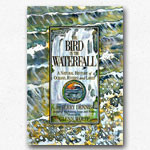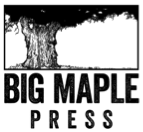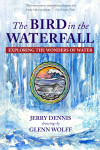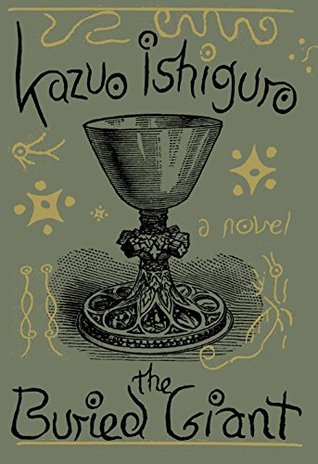
The new edition, published by Big Maple Press.
Glenn Wolff’s and my “forgotten” book has just appeared for the first time in paperback. The Bird in the Waterfall: A Natural History of Oceans, Rivers, and Lakes was published in hardcover in 1996 by HarperCollins Publishers, on the heels of our national bestseller, It’s Raining Frogs and Fishes. We were scheduled to launch Bird in the summer of ’96 with a national tour, and everyone had high expectations for success. Then came bad news.
HarperCollins was in trouble. Profits were down and the corporate suits weren’t happy about it. They fired the upper managers, then herded hundreds of authors out the door and locked it behind them. The accountants had decided it was cheaper to cancel books than to publish them, so they canceled them by the train-load.
The books already in production, including The Bird in the Waterfall, were published but they were orphaned. Our tour was cancelled, as were all other plans for promotion. There was barely enough money in the budget to send out a few copies for review. Glenn and I did the best we could, setting off on a road tour at our own expense that took us from New York to Boston, Cleveland, Ann Arbor, Chicago, Milwaukee, and Minneapolis. Two printings of the hardcover sold out quickly, but HarperCollins declined to print more. They also declined to bring it out in paperback.

- The original HarperCollins edition from 1996.
Over the years Glenn and I turned down several offers from publishers to reprint the book, including one from an Australian firm that wanted to dismantle it and repackage it as a coffee-table book, mostly because we didn’t think they “got” the book and would do it justice. Early this year our agent released it as an ebook and print-on-demand paperback under his firm’s imprint, DCA, and made it available in all the usual online places.
That was fine, but we wanted more. For years Glenn and I had dreamed of giving The Bird in the Waterfall the care that we felt it deserved. So we decided to do the job ourselves. Our first and most brilliant act was to team up with the multi-talented Gail Dennis, who has thirty years experience designing books, magazines, and other publications, and who presented us with many ideas of how to make the book better, from its cover and interior design, to its editorial content, to its title. The three of us formed a small press dedicated to publishing our works in special editions that will be available only in independent bookstores. With Gail as Creative Director and Glenn and I doing art and words, we’ve just released a spanking-new version of The Bird in the Waterfall. In a couple weeks we’ll release the new indie-store edition of It’s Raining Frogs and Fishes. Next year we’ll publish an original new book about wonders of the animal kingdom. You won’t find any of those editions at Amazon or Barnes and Noble or Walmart. I’ll have more to say about Big Maple Press in a few days. For now I want to talk about the title.
Titles are never easy. All my books have required dozens or hundreds of attempts. Often the right one has come in an ah-ha moment, but only after much effort. A Place on the Water and The Windward Shore arrived that way. The title “The Living Great Lakes” was the first to occur to me for that book, yet for some reason I went on to consider and reject more than 100 others before circling back to the original.
But no title has been as tough as The Bird in the Waterfall. During the three years that Glenn Wolff and I worked on the book we constantly fired ideas back and forth. One difficulty was the scale of the project. We wanted to include the entire panoply of water, from the molecular structure to the hydrological cycle; from the behavior of waves, currents, and tides to legends and myths and aquatic wildlife. How could we fit all that into one title?
In the end, with the publisher pressing us for a decision, we fell back on the title of one of our favorite chapters, about the American dipper and its habit of nesting near and even behind waterfalls. Our editor was okay with our choice, but he had doubts. Some friends advised us against it. But we were exhausted and out of time.
Now I’m fond of the title in the same way that I’m fond of the warped floors of our old farmhouse. For the new edition we’ve changed the subtitle to Exploring the Amazing World of Water, which is truer to the spirit of the book than the original. But we’re standing by the old title.
Not everyone thinks it’s a good idea. My favorite criticism so far was posted by a reader on Amazon.com:
“Great Book Hidden by a Lousy Title” by Mark Thrice (5 stars)
“I don’t know what led to the title, ‘The Bird in the Waterfall,’ but it was a misfortune. This book is powerful and teaches in a way that is compellingly interesting. It has nothing to do with birds and little to do with waterfalls. It’s about water and how water keeps our world going—a finite substance—there can never be more water than there is right now on our planet. Trees are slow-motion fountains of water. Get the book— there is so much more in it. Don’t make the mistake of judging this book by its title.”
Do you agree with Mark Thrice? Or should we have gone with Hydrologica?
How about Tidal Waves and Sea Monkeys?
Or should we have settled for Aquamania, Aquatica, Planet Aquatica, Aquatic Planet, Aquatic Oddities, or An Aquatica of the Mind?
Or From Spring to Sea, From Creek to River to Sea, From the River to the Sea, From Sea to Shining Tributary?
I can go on: A World of Water, Abundant Waters, The Spirit of Water, Water on Earth, The Lay of the Water, Sustained by Water, Taking the Waters, Overflowing With Water, Brimming With Water, or Water/Water.
Liquid Planet, Waves on the Planet, The Water Planet.
The Watery Realm, Realms of Water, Realms of Blue, Flow of Blue, Currents of Blue, World of Blue, Blue World, The Water is Blue, Vast Blue Waters, Beyond These Yellow Sands, Between These Yellow Sands, Between These Yellow Shores,Beyond the Deep Blue Sea, Beyond the Ocean’s Rim, Filled to the Brim, Beyond the Deep.
The First Element, Beyond the Shore, Between the Shores.
Over the Waterfall, Behind the Waterfall, Through the Waterfall, The Spirit in the Waterfall.
Prevailing Waters, The Tide is High, Water Tripping, Down in the Flood, Tsunami Dreams, A Mighty Swell, The Great Wave of Kanagawa, The Surface of the Deep, Riffles and Runs, Downstream, Water is Life, Water Itself, Whispering Brook/Bellowing Sea, Waves as Big as Mountains, The Shape That Water Takes, Aquatic Marvels, Water Wonders, It’s a Wet Wet World, All the Rivers Run to the Sea, Defining Water, Pondering Water, The Counsel of Water, Mindful of Water, Mind Full of Water, Literal Water, Neptune’s Realm, Neptune’s Kingdom, River Fast/Ocean Deep, Sargasso Dreams, Past Raging Rocks, The Book of Water, Of Water, About Water, Essential Water, Hands Filled With Water, Views of the Water, Pond to River to Sea, A Fondness for Water, Wade Until Dark.
And, finally, my absolute favorite, which Glenn faxed to me at 3 a.m. as we were finishing the book. It must have emerged from one of his fever dreams: I Think We’re All Hosers on This Boat Where Turtles Dream and Dolphins Dance.

The ebook edition published by DCA.










4 Replies